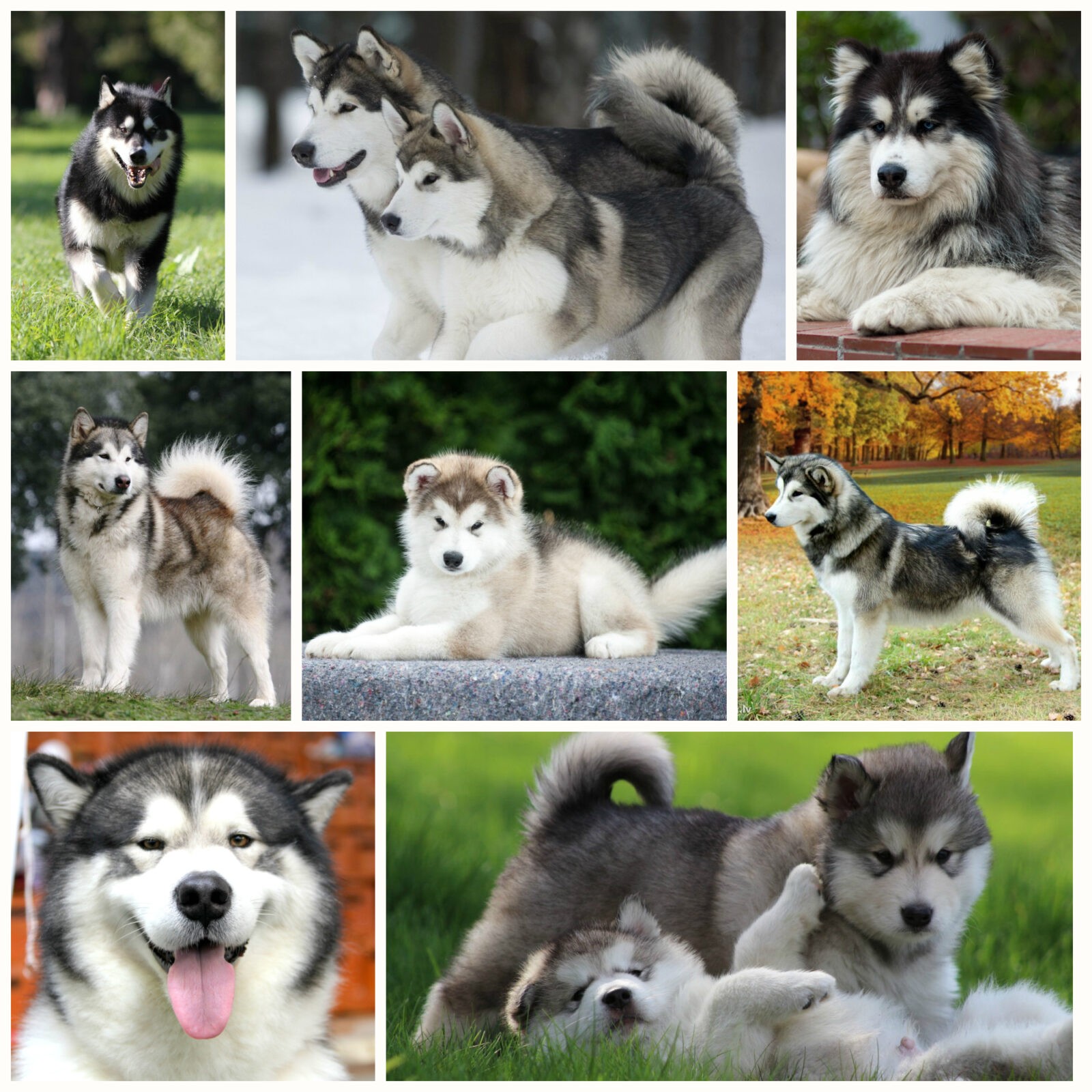
Brief description of the breed Alaskan Malamute
If you see an Alaskan Malamute for the first time, you will be amazed at its size. Outwardly, the dog looks like a wolf, so many people believe that dogs of this breed come from wolves. Malamutes often play the role of wolves in various films. Despite the wild appearance, the Alaskan Malamute is a kind pet.
These amazing dogs have incredible strength, energy, stamina, and intelligence. It is believed that the breed was originally bred to drag heavy sleds with cargo over long distances, as well as to help hunt seals and polar bears. Today, a dog is, first of all, a friend. Animals of this breed have achieved considerable success in various contests and competitions.
The Alaskan Malamute is very mobile. He will be happy to play with you, play sports, run in the park or swim in the sea. The pet will also be happy to sit with his owner at the TV, but still active games are much more interesting for the Malamute. Keeping this dog is not easy. Therefore, this breed is not suitable for an unprepared dog breeder.
For the normal development of the Alaskan Malamute, a large space is needed in which the dog will feel comfortable and confident. The independent nature of the animal causes new breeders to get the impression that the dog is stupid. In fact, this is not so, it’s just that the Malamute is very independent, so an individual approach is needed in raising the breed.
If you really want to have one dog, are ready to give her attention and love, as well as show patience and perseverance in education, then the Alaskan Malamute will become a true devoted friend for you.
basic information
| Breed name: | Alaskan Malamute |
| Country of origin: | USA |
| The time of the birth of the breed: | 2000 to 3000 years ago |
| Type of: | spitz and primitive breeds |
| The weight: | 34 - 38 kg |
| Height (height at the withers): | 58 - 64 cm |
| Life Expectancy: | 12 - 15 years old |
|
ICF classification:
|
Group 5, Section 1, Room 243 |
| Puppies price: | 300 – 1150 $ |
| Most popular nicknames: | List of nicknames for the Alaskan Malamute |
Evaluation of the characteristics of the breed Alaskan Malamute
| Adaptability
(a definition meaning how easily a dog can adapt to changes in life) |
🐶🐶🐶 |
| Shedding level
(Level and frequency of hair loss in the animal) |
🐶🐶🐶🐶🐶 |
| Tenderness level
(The level and amount of tenderness and affection that the dog gives in return for attention to itself) |
🐶🐶🐶 |
| Exercise needs
(Dog's daytime activity level) |
🐶🐶🐶🐶 |
| Social need
(The required number of contacts of the dog with other animals, as well as people) |
🐶🐶🐶🐶 |
| Apartment content
(A factor that determines the level of noise and other inconveniences that a dog can deliver to owners in relation to the size of the apartment to the size of the dog) |
🐶 |
| Grooming
(The number of bathing, brushing, and the number of professional grooming sessions required for the dog) |
🐶🐶🐶🐶🐶 |
| Friendliness in an unfamiliar environment
(Features of the behavior of a dog in a society with strangers or in an unfamiliar environment) |
🐶🐶🐶🐶 |
| Tendency to bark
(Tendency to bark and its frequency and volume) |
🐶🐶🐶🐶 |
| Health issues
(Potential health status of the dog) |
🐶🐶🐶 |
| Territoriality
(The dog's tendency to protect his home, yard, or even his owner's car) |
🐶🐶🐶🐶🐶 |
| Friendliness to cats
(The tendency towards tolerance for cats and decreased manifestation of hunting instincts) |
🐶 |
| Intelligence
(The ability of the dog to think and solve emerging difficulties (not to be confused with learning!) |
🐶🐶🐶 |
| Education and training
(The level of difficulty in training the dog to perform certain actions) |
🐶🐶 |
| Friendliness to children
(A factor that determines how friendly a dog is to children, whether he likes to play with them and tolerate some childish pranks) |
🐶🐶🐶🐶 |
| Game activity
(The concept is determined by its very name, and, as a rule, is found in almost all dogs) |
🐶🐶🐶🐶 |
| Observation
(The ability of a dog to detect the presence of a stranger on its territory) |
🐶🐶🐶🐶🐶 |
| Friendliness to other dogs
(The tendency of the dog to find common language with his other relatives) |
🐶 |
Photo of the Alaskan Malamute:
Origin story
The Alaskan Malamute is one of the oldest Arctic sled dogs. Thousands of years ago, the breed crossed the ocean and came from Siberia to Alaska. It is believed that the breed was developed by the ancient northern Malamute tribe, who used dogs for transportation, as well as for hunting seals and polar bears. The animals also helped move heavy loads on sledges.
This dog was also popular among the Eskimos. Active breeding of Malamutes began during the gold rush, when hardy, strong dogs were required that could live in harsh northern conditions. True, in those days, the crossing of the Alaskan Malamute with local dogs began, so the breed almost disappeared. Thanks to the Malamute tribe, the breed has survived.
Already at the beginning of the twentieth century, the breed began to actively develop. First of all, this was due to the need for hardy dogs, which could help scientists during difficult Arctic expeditions.
It is worth noting that in the 1900s a slightly new variety of this breed was bred, which was somewhat different in appearance. These dogs were actively used during the First World War.
During World War II, most Alaskan Malamutes went to the front to help fight the enemy. This was due to an acute shortage of sled dogs. Unfortunately, many dogs never returned from the war.
The Alaskan Malamute Club was first organized in the United States in 1935. In the same year, the breed was officially recognized by the American Kennel Club. Today, the Alaskan Malamute is ranked 55th among all breeds registered by the American Kennel Club.
The nature of the Alaskan Malamute
Maintenance and care
Training and education
The industriousness of Malamutes is laid down at the genetic level. Despite this, they are quite difficult to train and train, and at home it becomes an overwhelming task for most dog breeders. To train and train dogs of this breed, you need a real specialist with perseverance and knowledge of the characteristics of the breed.
Alaskan Malamutes are the best dogs for racing, as well as reliable companions during northern expeditions. For example, Admiral Byrd used these dogs on his expedition to the North Pole. Often dogs of this breed are involved in search and rescue operations, especially when it comes to rescuing people caught in an avalanche.
Health and disease
Some interesting facts
- It is not recommended to purchase a puppy of this breed for unprepared, novice dog breeders.
- The Alaskan Malamute is very independent, so all members of the family will have the task of raising the dog in such a way that it understands its place and importance in the family.
- Malamutes love to dig holes. The yard must be securely fenced with a fence dug into the ground.
- The Alaskan Malamute is very active and has a complex character, it is necessary to make a lot of efforts for his upbringing and training. Otherwise, the animal will show the worst sides of its character.
- Early socialization of the dog will be the key to successful education. The right approach will help raise an obedient dog from a pet that will meet all the requirements of the owner.
- The hunting instincts of the Malamute appear quite often. The dog can chase cats, small relatives, squirrels and other small animals. The only way that can minimize such manifestations is early socialization.
- The Alaskan Malamute is prone to an annual molt that occurs twice a year. The thick coat of this animal suggests that a hot climate is not suitable for a pet.
- Dogs of this breed rarely bark. The main form of communication you can hear is a small howl. This is another point that points to the similarity dogs with a wolf.
- If you want a healthy dog, never buy a puppy from random sellers. Trust only trusted dog breeders!
Nurseries and breeders
We borrowed material from the wonderful site of our partners DOGCATFAN.COM about cats and dogs, the author dogcatfan

